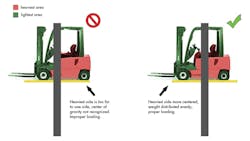Tech Tip: How to balance weight properly on a lift
When purchasing any two-post lift, there are certain aspects as to what defines weight capacity that many competing companies take advantage of to falsely claim that a lift can withstand a specific amount of weight. You could, in fact, be putting yourself in danger through this misinformation. To elaborate, two-post lifts have four arms (of either symmetric or asymmetric design). These are positioned under the vehicle to stabilize it at specific points.
Why are these specific points important? When using a two-post lift, the vehicle must be positioned according to its center of gravity so as to evenly distribute the total weight among the four arms. It is crucial that you be aware of the weight capacity per arm, which should be about 25 percent of the lift's total reported weight specifications. If this limit is exceeded on any of the four arms, mechanical failure or damage will follow.
In some instances, you may have a vehicle with disproportionate weight between the front and rear ends, such as with a forklift or loaded truck. In such scenarios, a lift operator must use common sense to reestablish the center of gravity to accommodate the uneven weight, so that each arm will still receive 25 percent of the total load. This may affect where you position your vehicle on the lift.
Not every company will tell you that the advertised lifting capacity for competing lifts is bogus. We recommend that you don't leave anything to chance and always purchase the lift with the next larger weight capacity, compared to the lift you originally were considering.
Information provided by: Dannmar Equipment
